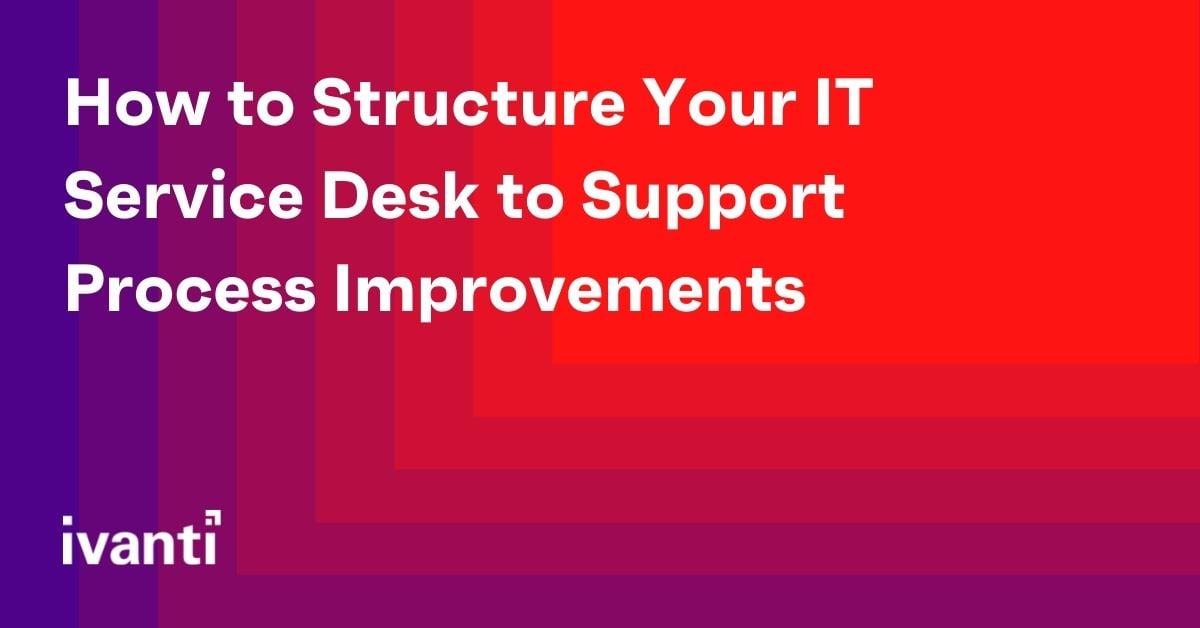How to Structure Your IT Service Desk to Support Process Improvements
Buying a modern service desk tool won’t solve all your problems in and of itself. Although these tools are designed to ensure general best practices are met, service desk tools must also be configured to address your organization’s specific essential protocols.
In a recent Info-Tech study that surveyed 623 organizations worldwide, the most frequently adopted service management processes are:
- Incident management (94.86 percent)
- Change management (87.96 percent)
- Problem management (71.11 percent)
However, despite adopting these processes, aside from a few pockets of maturity and IT service management (ITSM) improvement, most CIOs reported limited and sometimes negative results, according to Standardize the Service Desk, a publication from Info-Tech Research Group. Deeper analysis showed that the majority of organizations were focused on selection and implementation and failed to put equal effort behind structuring service desk processes.
Without the proper foundation and fine-tuning, their new tool was not positioned to perform at its best.
Structuring Service Desk Processes Leads to Maturity
Building a solid organizational structure that supports your processes is the hidden work that signifies a mature system.
Standardization is essential to creating an environment that’s mapped to your business’ needs, allowing for the vast configuration that will make the service desk more intuitive and maximize its potential to have the best possible impact.
Building a solid organizational structure for your service desk also helps to hold each sector of your business accountable by aiding in assigning roles and responsibilities, enforcing improved processes, and outlining the order in which certain actions are taken and prioritized.
When structuring your service desk, you’ll first need to assess all facets of the existing ITSM and make improvements from the ground up. Consider utilizing the methods below to provide your organization with the structure it needs to properly task and funnel service desk inquiries.
Improve Your CX With a Tiered Generalist Service Desk
Take a look at some of the advantages your organization will experience when you implement a tiered service desk:
Increased Order and Organization
Systems that do not have a tiered response in place tend to get bottle-necked from the very beginning.
Customer requests can easily get lost in the shuffle, particularly if users are forced to muddle through multiple dispatch numbers or contact emails to register their issue. Imagine if they did all the work to find the right contact information only to reach a service desk team member who must then send them on to another specialist to have their issue resolved. Exhausted by the unclear route to completing the process, both customers and team members are left unsatisfied, even if in the end the problem is fixed.
With a flood of requests coming through your system, it’s pertinent to have a clear hierarchy in practice and replicated through your ITSM.
Faster Response Time
Employing a tiered system to navigate your service desk allows your business to respond faster and more efficiently. Through a funneling process, open tickets are escalated to certain types of support based on the level of technical specificity required.
With a tiered system, all customers are initially directed to a single point of contact. There, they confirm the issue and are sent to either Level 1, a frontline service desk team member; Level 2, a second-tier support member with a deeper generalist skill set; or Level 3, a specialist with knowledge of specific applications or technology. Because issues are resolved more efficiently with less time on hold or being tossed around through the system, this model reports a higher customer experience (CX).
Info-Tech research shows that tiered service desks with a first-tier generalist resolution rate over 60 percent have the highest customer satisfaction and best operating costs of all other types of structures.
Significant Cost Savings
A tiered system also directly impacts your bottom line.
As tickets work their way up the funnel, the average volume decreases as Level 1 agents take the brunt of the load with more general and easy-to-solve issues, and Level 2 and Level 3 agents handle more complex cases.
Ultimately, by properly funneling users through a well-established and vetted request system, high volume/low level issues are directed to generalists and low volume/high level issues are sent to technical specialists, essentially saving you money in labor and time on task.
Info-Tech research shows that with the tiered generalist model, most businesses experience about 48 percent more cost-effectiveness, saving around $3.5M for an enterprise producing just 1,000 calls per week.
The success of this model depends on several factors, including effective communication between service desk tiers, efficient escalation procedures, clear guidelines on prioritizing tickets, and clear service support metrics. However, with a deep commitment to building strategy and maintaining processes, a tiered model can truly influence positive outcomes.
Automate and Empower Using the Shift-Left Strategy
Imagine that a Level 2 customer incident can be moved back to a Level 1 incident and resolved by the user instead of a specialist. The goal of this process, known as the shift-left strategy, is to move problem resolution closer to the end user by directing them to a self-service portal whenever possible or appropriate.
By shifting end-users from specialists to generalists and from generalists to self-service, users experience a boost in satisfaction and companies see lower service support costs. Companies save on support costs by better filtering common issues or easily-resolved requests at the front of the funnel while pushing the most complex technical problems up to more skilled, higher-level service desk members (pg. 38). Typically, organizations have analysts resolve the majority of incidents, meaning companies are using their most skilled and highly paid specialists to address the least complex issues. Shifting left allows those issues to move to self-service (lower cost per ticket) and generalists (lower paid), saving businesses on the cost of labor while still offering a satisfactory experience.
An InfoTech report showed that customers who were satisfied with the effectiveness of the service desk also rated all other IT processes 70% higher than dissatisfied end-users. As well, users who were satisfied with the timeliness of the service desk rated all other IT processes 40% higher than dissatisfied users (pg. 8 in Standardize the Service Desk). These noticeable improvements in satisfaction are highly reliant on the fact that users can resolve their own issues quickly and effectively without advanced wait times, resulting in a faster and more effective resolution rate.
Enable Self-Service Portals
At the start of the service desk consultation, end users are met with a ground zero level of support that allows them to address the issue themselves via an automated self-service portal. This stage presents the IT service group with a dashboard that consists of resolutions for issues such as password resets, general information updates, and some troubleshooting. Other examples of a common low-risk change request would be a server reboot.
Even in these smaller requests, users are left feeling empowered now that solutions can be achieved when they desire and without much IT support interaction required. Bonus for the company is that self-service portals entail the least cost to the organization. This scenario is a win-win.
Test Often and Right Away
Another thing to consider when rolling out the shift-left strategy is to test frequently. Traditionally, organizations focus on testing right before a release, putting off the process of correcting errors until after implementation. But delaying testing can make it harder to detect shortcomings later on once the portal is already in use.
To achieve a higher level of stability, combine automation coding and testing into one activity to immediately uncover any pitfalls in the automation. With the shift-left approach and ample time to measure and tweak responses, your organization can detect defects earlier and quickly improve the overall quality of the application for users.
Engage Technicians to Ensure Quality Data Is Captured
Accountability is at the heart of a well-structured organization. Without the importance placed on roles and contribution to the service desk, the standardization of the service desk will not be successful. Members across IT and beyond must be fully engaged and understand their purpose in providing unwavering service support.
Start by analyzing your ITSM dashboard and ensure the right metrics are captured. Every system should be built to gather information that shapes the goal of your organization. The first step to engaging your technicians is to help them identify quick-win and high-priority tickets as well as anticipate potential SLA breaches. From there, introduce meaningful metrics for them to focus on, including end-user satisfaction, ticket volume, first-contact resolution, and the average time to resolve incidents or fulfill service requests.
Leveraging a healthy relationship with your team and allowing them ownership in the structuring process of the service desk will undoubtedly have lasting effects on the quality of your rollout. Communicate your goals and reward anticipating the needs of your users. Whichever of these methods you choose, you will start to see consistent maturation of your ITSM.
Ready to Consider a New ITSM Tool?
Getting a new IT service desk in place is just the beginning. Your next step—and it’s an important one—is to configure your ITSM solution. The Info-Tech Research publication, “Standardize the Service Desk,” provides a blueprint for roll-out success, enabling your organization to:
- Increase user satisfaction.
- Boost service desk efficiency.
- Cut time and cost to resolve tickets.
- Build a foundation for future projects.

